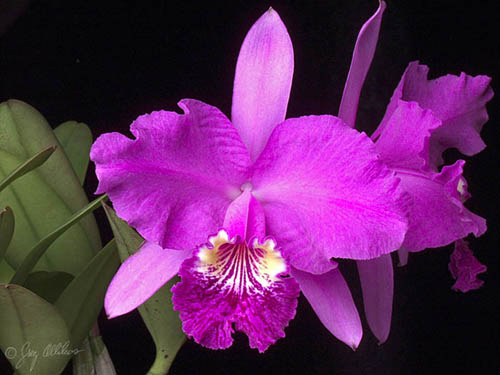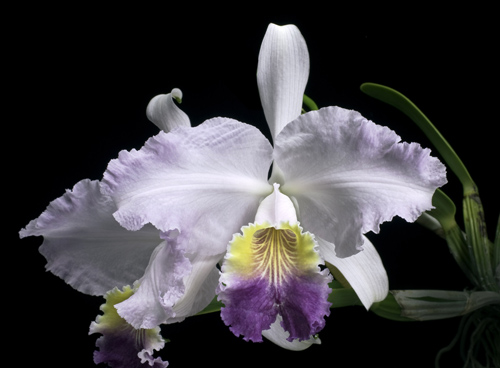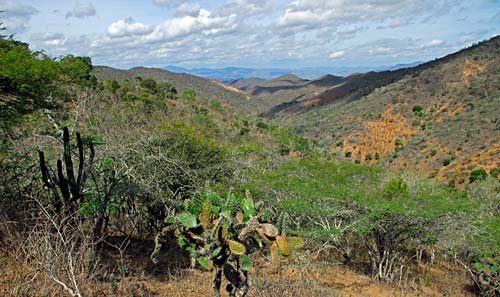
Cattleya lueddemanniana 'Macaray' AM/AOS



Cattleya lueddemanniana 'Macaray' AM/AOS
The first description of this species was done by the German botanic H. G. Reichenbach in 1854 in Xenia Orchidacea, based on a plant without an exact known identity. This plant was sent under the name of Cattleya maxima to the well known collection of Mr. Pescatore in St. Cloud, near Paris, France. H. G. Reichenbach in his description mentioned that the dry flower had a natural spread of 26 cm (10.5 inches) and also about the narrowness of the labellum in comparison with C. labiata. But he never mentioned the two small horns (wings) at the apex of the column, which only C. lueddemanniana has. Once H. G. Reichenbach noticed that it was a different Cattleya species than C. maxima, he decided to name it after Mr. Lueddemann, who was the head gardener of Pescatore. About 10 years later in England, after C. lueddemanniana was described in France by H. G. Reichenbach, in Gardener's Chronical, p. 404 in adnot., without any taxonomic revue, the same plant was named Cattleya speciosissima Hort. This is one of the reasons why still today this species is named in England and especially in Venezuela C. speciosissima.
Cattleya lueddemanniana is endemic to the northern Coastal Range of Venezuela and grows from the sea level up to 1,800 feet elevation. In this part of the country we have very little rainfall and the vegetation is totally xerophytic. The temperature during the daytime can get as high as 90° F and at night cools down to the 60°'s F. The flowering season is from late December to March. In some occasions and mainly on huge plants which grow near the sea, we can observe a second flowering season from September to November. The bloom sheath appears right after the growth matures. In some cases the pseudobulbs and the leaves have some maroon anthocyanin spots. This pigmentation disappears once the flowers get older. C. lueddemanniana has very round bulbs which have two to three segments, one of the characteristics that identifies this species. The leaves are relatively short, round and very thick in comparison to the long pseudobulb. This is probably due to the very high light intensity and temperature of the habitat.
In the habitat exists a natural hybrid of C. mossiae and C. lueddemanniana, called Cattleya x gravesiana. The habitat of the C. mossaie is the same northern coastal range, only difference is that this latter species grows at higher elevations (from 3,600 to 4,600 feet). Some taxonomists think that C. lueddemanniana should be separated in two different sub-species (groups of plants with some visable differences from two different geographical areas), but the habitat is not really divided or separated. The difference is that plants from the eastern part of the Coastal range have a bigger, fuller flower and the two yellow eyes on the lip are not very intense. The C. lueddemanniana from the western part of the habitat have smaller flowers but a much darker purple color and a very bright yellow on the lip.

Cattleya lueddemanniana fma. coerulea 'KG's Violetta' HCC/AOS
C. lueddemanniana has several different color forms: alba, semi-alba, coeruela and the tipo form. In the last 10 years a lot of improvement has been achieved by hybridizers line-breeding select parents, and these once-rare color forms are now very easy to obtain.
This beautiful Cattleya species is very easy to grow and adapts very quickly to new environments which is why it is recommended for the beginner. General "Cattleya Conditions" would be the perfect recommendation. Water it once or twice a week, use a very quick drying medium and preferably, a wooden basket or a clay pot allowing their roots to dry quickly. C. lueddemanniana doesn't like to "sleep" with wet feet (roots). It can tolerate a high intensity of light, but it is not necessary to grow and flower well. The best time for repotting is right after the blooming, when the new pseudobulb starts to make new roots.

The habitat of Cattleya lueddemanniana in Lara State, Venezuela
Many thanks to Michael Sinn for this essay.

Get notified when orchid vendors have special promotions and exclusive savings.
